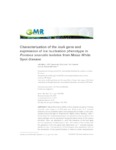Por favor, use este identificador para citar o enlazar este ítem:
http://www.alice.cnptia.embrapa.br/alice/handle/doc/1065205Registro completo de metadatos
| Campo DC | Valor | Lengua/Idioma |
|---|---|---|
| dc.contributor.author | MILLER, A. M. | pt_BR |
| dc.contributor.author | FIGUEIREDO, J. E. F. | pt_BR |
| dc.contributor.author | LINDE, G. A. | pt_BR |
| dc.contributor.author | COLAUTO, N. B. | pt_BR |
| dc.contributor.author | PACOLA-MEIRELLES, L. D. | pt_BR |
| dc.date.accessioned | 2017-02-22T11:11:11Z | pt_BR |
| dc.date.available | 2017-02-22T11:11:11Z | pt_BR |
| dc.date.created | 2017-02-22 | pt_BR |
| dc.date.issued | 2016 | pt_BR |
| dc.identifier.citation | Genetics and Molecular Research, Ribeirão Preto, v. 15, n. 1, p. 1-8, 2016. | pt_BR |
| dc.identifier.uri | http://www.alice.cnptia.embrapa.br/alice/handle/doc/1065205 | pt_BR |
| dc.description | Maize White Spot (MWS), a foliar disease caused by Pantoea ananatis, could cause up to 60% yield loss. Some strains of P. ananatis harboring the ice nucleation gene inaA catalyze the formation of ice nuclei, causing tissue damage at temperatures slightly below freezing. Little is known about the relationship between the presence of the ina gene in this maize pathogen and its expression during the phenomenon of ice nucleus formation. Here, we attempted to verify the presence of the inaA gene and the expression of phenotype in vitro. The identity of the isolates and the presence of the inaA gene were determined by P. ananatis speciesspecific primers. The expression of the inaA gene was assessed in vitro by the visualization of ice-crystal formation in water at subzero temperatures. A total of ninety P. ananatis isolates from MWS lesions were characterized. The presence of the inaA gene was confirmed by gel electrophoresis of the 350-400-bp PCR products. The inaA primers did not lead to DNA fragment amplification in three isolates. The ice nucleation phenotype was expressed in 83.34% of the isolates carrying the inaA gene. Our study showed that the ice nucleation in P. ananatis isolated from MWS lesions was dependent on the presence of a functional ina gene in the genome. We also found evidence indicating that some P. ananatis strains have a mutated form of the inaA gene, producing a non-functional ice nucleation protein. This is the first report on inaA gene characterization in P. ananatis isolates from Maize White Spot. | pt_BR |
| dc.language.iso | eng | eng |
| dc.rights | openAccess | eng |
| dc.subject | Doença foliar | pt_BR |
| dc.subject | Bactérias fitopatogênicas | pt_BR |
| dc.subject | Variabilidade | pt_BR |
| dc.subject | Fenótipo INA | pt_BR |
| dc.title | Characterization of the inaA gene and expression of ice nucleation phenotype in Pantoea ananatis isolates from Maize White Spot disease. | pt_BR |
| dc.type | Artigo de periódico | pt_BR |
| dc.date.updated | 2017-02-22T11:11:11Z | pt_BR |
| riaa.ainfo.id | 1065205 | pt_BR |
| riaa.ainfo.lastupdate | 2017-02-22 | pt_BR |
| dc.identifier.doi | 10.4238/gmr.15017863 | pt_BR |
| dc.contributor.institution | Universidade Estadual de Londrina; JOSE EDSON FONTES FIGUEIREDO, CNPMS; Universidade Paranaense; Universidade Paranaense; Universidade Estadual de Londrina. | pt_BR |
| Aparece en las colecciones: | Artigo em periódico indexado (CNPMS)  | |
Ficheros en este ítem:
| Fichero | Descripción | Tamaño | Formato | |
|---|---|---|---|---|
| CharacterizationinaA.pdf | 463.46 kB | Adobe PDF |  Visualizar/Abrir |









